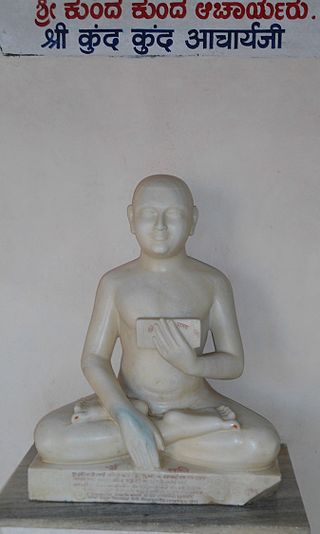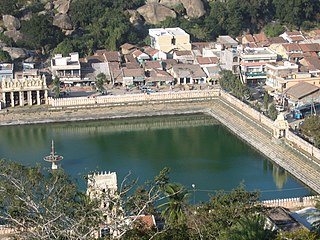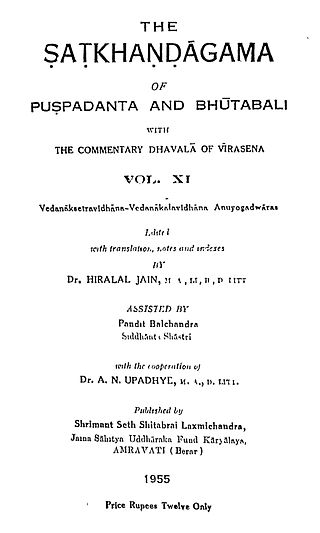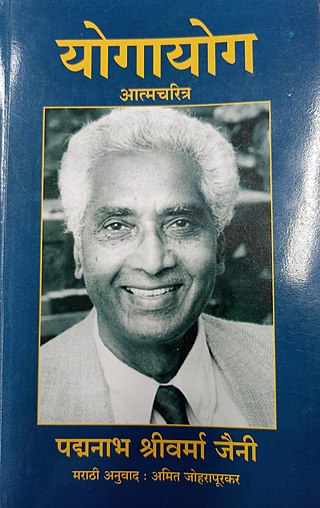Vidyadhar Pasusa Johrapurkar, also spelled as Vidyadhar Pasusa Joharapurkar (born 1935), is a Sanskritist, social anthropologist, and historian who specializes in Jainism and Jain philosophy.
Vidyadhar Pasusa Johrapurkar, also spelled as Vidyadhar Pasusa Joharapurkar (born 1935), is a Sanskritist, social anthropologist, and historian who specializes in Jainism and Jain philosophy.
Born in Nagpur, Johrapurkar completed his M.A. in 1956 and Ph.D. in 1959 from Nagpur University.
Johrapurkar's early love for reading was inspired by his grandfather Nemasav's personal library. As a young man, he joined the Jain Svayamsevak Sangh, which sparked his interest in social service. His close friend Shantikumar Killedar encouraged his study of Indian history and social anthropology.
He worked as a Professor of Sanskrit in the Department of Education under the Government of Madhya Pradesh. Throughout his career, he taught Sanskrit at various government colleges, including those in Nagpur, Jabalpur, Jaora, Mandala, and Bhopal. He eventually retired as Professor and Head of the Department of Sanskrit at Government College, Keolari, District Seoni, Madhya Pradesh.
Johrapurkar has published nearly 100 scholarly articles in well-known magazines like Sanmati and Anekanta . He has also been interviewed by Nagpur Doordarshan and Radio Nagpur.
One of his notable works, Bhattaraka-Sampradaya, offers a detailed reconstruction of Digambar Jain monastic lineages through the study of Jain inscriptions. [1] [2] [3]

Ādi purāṇa is a 9th-century CE Sanskrit poem composed by Jinasena, a Digambara monk. It deals with the life of Rishabhanatha, the first Tirthankara.

Ācārya Bhadrabāhu was, according to both the Śvetāmbara and Digambara sects of Jainism, the last Shruta Kevalin in Jainism.

Kundakunda was a Digambara Jain monk and philosopher, who likely lived in the second century CE or later.

A Bhaṭṭāraka heads traditional Digambara Jain institutions. He is responsible for training scholars, maintenance of libraries, managing endowments, presiding over installation ceremonies and running Jain institutions.

Bagherwal is a digambar Jain community originally from Baghera, a princely state in Rajasthan. The town is situated in Ajmer district of Rajasthan near Kekri.

Mallinatha was the 19th tīrthaṅkara "ford-maker" of the present avasarpiṇī age in Jainism.
Kashtha Sangha was a Digambar Jain monastic order once dominant in several regions of North and Western India. It is considered to be a branch of Mula Sangh itself. It is said to have originated from a town named Kashtha.

Balatkara Gana is an ancient Jain monastic order. It is a section of the Mula Sangh. It is often termed Balatkara Gana Sarasvati Gachchha. Until the beginning of the 20th century it was present in a number of places in India. However all its seats in North India became vacant in early 20th century. It survives only at Humbaj in Karnataka, which is its ancient seat.

Nathuram Premi was an Indian writer, publisher, poet, editor, and linguist in the field of Jainism as well as Hindi literature. A budding poet, he wrote under the nom de plume of "Premi". Although belonging to the Digambara sect of Jainism, he adopted a non-sectarian attitude and published and translated many Digambara as well as Śvetāmbara works. Working as a clerk in a firm in Mumbai he rose to establish his own publishing house and bookstore Hindi Granth Ratnākar Kāryālay which published works of many of the biggest names in Indian literature, including Munshi Premchand, Hajariprasad Dvivedi, Jainendrakumar, Yashpal, Swami Satyabhakta, Sharatchandra Chatterjee and Rabindranath Tagore. The bookshop and publishing house now called Hindi Granth Karyalay is now being managed by his grandson and great-grandson 100 years after its establishment.

The Ṣaṭkhaṇḍāgama is the foremost and oldest Digambara Jain sacred text. According to Digambara tradition, the original teachings of lord Mahavira were passed on orally from Ganadhar, the chief disciple of Mahavira to his disciples and so on as they had the capability of listening and remembering it for always. But as the centuries passed there was downfall in these capabilities and so Ācārya Puṣpadanta and Bhūtabali penned down the teachings of Mahavira in Ṣaṭkhaṇḍāgama. Therefore the Ṣaṭkhaṇḍāgama is the most revered Digambara text that has been given the status of āgama.

Jainism is a religion founded in ancient India. Jains trace their history through twenty-four tirthankara and revere Rishabhanatha as the first tirthankara. The last two tirthankara, the 23rd tirthankara Parshvanatha and the 24th tirthankara Mahavira are considered historical figures. According to Jain texts, the 22nd tirthankara Neminatha lived about 84,000 years ago and was the cousin of Krishna.
Kevala jnana or Kevala gyana, also known as Kaivalya, means omniscience in Jainism and is roughly translated as complete understanding or supreme wisdom.

Padmanabh Shrivarma Jaini was an Indian born scholar of Jainism and Buddhism, living in Berkeley, California, United States. He was from a Digambar Jain family; however he was equally familiar with both the Digambara and Śvetāmbara forms of Jainism. He has taught at the Banaras Hindu University, the School of Oriental and African Studies (SOAS), the University of Michigan at Ann Arbor and at the University of California at Berkeley, from which he retired in 1994. Jaini was the author of several books and papers. His best known work is The Jaina Path of Purification (1979). Some of his major articles have been published under these titles: The Collected Papers on Jaina Studies (2000) and Collected Papers on Buddhist Studies (2001). He died on 25 May 2021 at Berkeley at age 97.

Hindi Granth Karyalay is an Indian publishing house and specialized book store dealing in books pertaining to Jainology and Indology in English, Hindi, Sanskrit, Prakrit and Apabhramsha. It was established in Mumbai, India in 1912 by its founder Nathuram Premi. It publishes and distributes serials, monographs, and scholarly publications on Indian religions, philosophy, history, culture, arts, architecture, archaeology, language, literature, linguistics, musicology, mysticism, yoga, tantra, occult, medicine, astronomy, astrology and other related subjects, and to date have published over 100 works of noted Indian and International authors and scholars.

Digambara is one of the two major schools of Jainism, the other being Śvetāmbara (white-clad). The Sanskrit word Digambara means "sky-clad", referring to their traditional monastic practice of neither possessing nor wearing any clothes.

Jainism is an Indian religion which is traditionally believed to be propagated by twenty-four spiritual teachers known as tirthankara. Broadly, Jainism is divided into two major schools of thought, Digambara and Śvetāmbara. These are further divided into different sub-sects and traditions. While there are differences in practices, the core philosophy and main principles of each sect is the same.

Samantabhadra was a Digambara acharya who lived about the later part of the second century CE. He was a proponent of the Jaina doctrine of Anekantavada. The Ratnakaranda śrāvakācāra is the most popular work of Samantabhadra. Samantabhadra lived after Umaswami but before Pujyapada.

Vividha Tirtha Kalpa, originally named Kalpa-pradeepa, is a widely cited Jain text composed by Jinaprabha Suri in the 14th century CE. It is a compilation of about 60 Kalpas (sections), most of them give the accounts of major Jain Tirthas.

Siddhantacharya Pandit Phoolchandra Shastri was a Jain scholar, writer, editor, freedom fighter, social reformer and an intellectual giant in the field of Jainism. He is best known for dedicating a major part of his life in translating to Hindi the foremost and the oldest Digambara Jain Canon Shatkhandāgama and Kasayapahuda and its commentaries Dhavala, Maha-Dhavala and Jai-Dhavala. He was also an active member of Indian National Congress during the Indian freedom struggle. He was also a strong advocate and proponent of abolishing many evils within the Jain community. Panditji was also the founding member of many institutes of learning and scholarship. As a recognition of his contribution to Jain philosophy, he was conferred a title of "Siddhantacharya" at Jain Siddhant Bhavan, Ara (Bihar) in 1962 by the Governor of Bihar Ananthasayanam Ayyangar.

Śvetāmbara Terapanth is a sect of the Śvetāmbara Jainism that was founded by Acharya Bhikshu in Vikram Samvat 1817. Acharya Bhikshu believed in strict adherence to the canonical code of conduct for ascetics as prescribed by Lord Mahavira. Acharya Bhikshu rigorously followed the principles and thus set an example for all to follow. He showed the way for the life of discipline, purity and self-control.